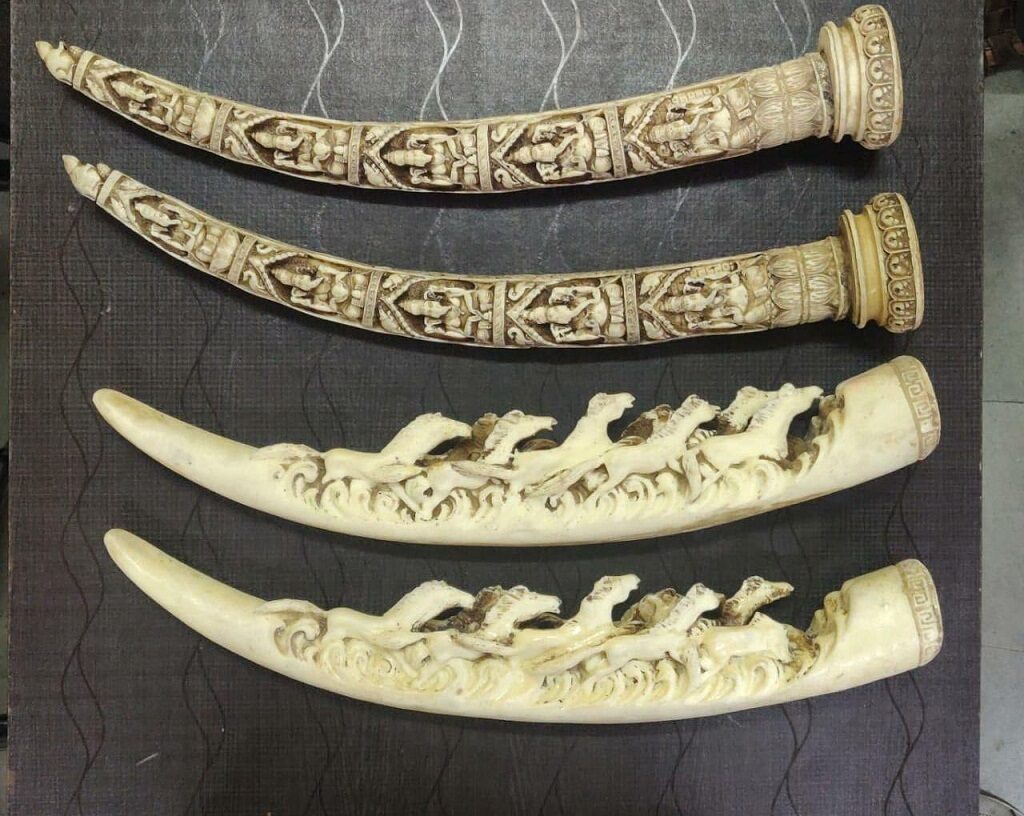Elephant tusks worth Rs 80 lakhs seized by Pune police Crime Branch

Sumit Singh
Pune, September 21, 2019 : In a major detection, the sleuths from the Crime Branch of Pune city police on Saturday recovered four elephant tusks, with carvings, which are valued at Rs 80 lakhs in the international market.
Acting on tip-off received by policemen Yashwant Khandare and Mohsin Shaikh of Crime Branch unit 2, a team arrested Bhima Bogriya Mudawat alias Chavan (50) of Ananadnagar, Hadapsar, who hails from Telangana. Further investigation is going on, informed DCP (crime) Bachchan Singh.
The elephant has been accorded the highest possible protection under the Indian wildlife law through its listing under Schedule I of the Wildlife (Protection) Act, 1972 of India. This means that hunting/trading this species can attract rigorous imprisonment of up to seven years and a minimum fine of Rs 25000.
The ivory trade is the commercial, often illegal trade in the ivory tusks of the hippopotamus, walrus, narwhal, mammoth, and most commonly, African and Asian elephants. Ivory has been traded for hundreds of years by people in regions such as Greenland, Alaska, and Siberia.
Concerned at the primary need to restore the elephant habitats and reduce suffering of both elephant as well as the human population, the Government of India launched “Project Elephant” in 1991-92 as a Centrally Sponsored Scheme of the Ministry of Environment and Forests. It was intended to provide financial and technical support to the elephant range states of India for the protection of elephants, their habitats and corridors and address issue of human- animal conflict. It also sought to promote welfare of captive elephants.
Main activities under the Project are as follows:
The C.S.S. Project Elephant aims at providing support to the States for achievement of the following broad objectives:-
-
- conserve and protect viable population of wild elephants in their natural habitats in the country;
- To conserve and protect and, where necessary, to restore natural habitats and traditional corridors/migratory routes or movement paths used by the elephants — through eco-restoration, acquisition etc ;
- To take concrete measures to protect the elephants from poaching and other threats by taking suitable measures like deployment of patrolling squads, intelligence gathering etc;
- To create a viable mechanism to ensure inter-state and regional and national level coordination in protecting and conserving the elephant and its ranges;
- To create infrastructure and other facilities for conservation support activities like veterinary care, management training, humane methods of capture,
tranquilizing and translocation etc of wild elephants, as and when required;
- To improve and create infrastructure for the welfare of elephants in domestic use, including their veterinary care, training of mahouts and supervisory staff in proper treatment of elephants in captivity;
- To encourage and create facilities for research related to the management and ecology of elephant, and also with respect to its veterinary care;
- To take appropriate steps to mitigate man-elephant conflict through suitable measures, such as eco-development, public education and awareness programmes, scientific management, ex-gratia payments, deployment of anti-depredation teams etc.
- To take measures for detection and prevention of diseases in wild elephants.
STEERING COMMITTEE OF PROJECT ELEPHANT:
A Steering Committee for the Project Elephant has been constituted, which includes representatives of the Government as well as non-government wildlife experts and scientists. The term Steering Committee is for a period of three years. It has a responsibility to review the implementation of Protect Elephant and provide guidance from time to time. Besides, the Chief Wildlife Wardens of the 12 elephant range states and the heads of the four premier institutions, namely Wildlife Institute of India (WII), Zoological Survey of India (ZSI), Botanical Survey of India (BSI) and Indian Veterinary Research Institute (IVRI) are permanent invitees to the meetings of the Steering Committee. The Committee advises the centre on the project related issues.
Estimation of wild elephant population in the year 2007, 2012 and 2017.
The all India enumeration of wild population of elephants in the country is carried out at every five year interval. The comparative figures as below for the states shows that the estimated population of wild elephants in the country has increased to 29964 as compared to 27669-27719 in 2007.
Elephant Reserves
Elephant Reserve is a management entity notified by the State Governments as per recommendation of Govt. of India. It includes Protected Areas, forest areas, corridors and private/reserve lands. Till now 30 Elephant Reserves (ERs) extending over about 65507.42 sq km have been formally notified by various State Governments
Monitoring of Illegal Killing of Elephants (MIKE) Programme
Mandated by COP resolution of CITES , MIKE program started in South Asia in the year 2003 with following purpose — To provide information needed for elephant range States to make appropriate management and enforcement decisions, and to build institutional capacity within the range States for the long-term management of their elephant populations. The main objectives of the MIKE are: To measure levels and trends in the illegal hunting of elephants; To determine changes in these trends over time; and To determine the factors causing or associated with such changes, and to try and assess in particular to what extent observed trends are a result of any decisions taken by the Conference of the Parties to CITES Under the programme data are being collected from all sites on monthly basis in specified MIKE patrol form and submited to Sub Regional Support Office for South Asia Programme located in Delhi who are assisting Ministry in the implementation of the progremme.





